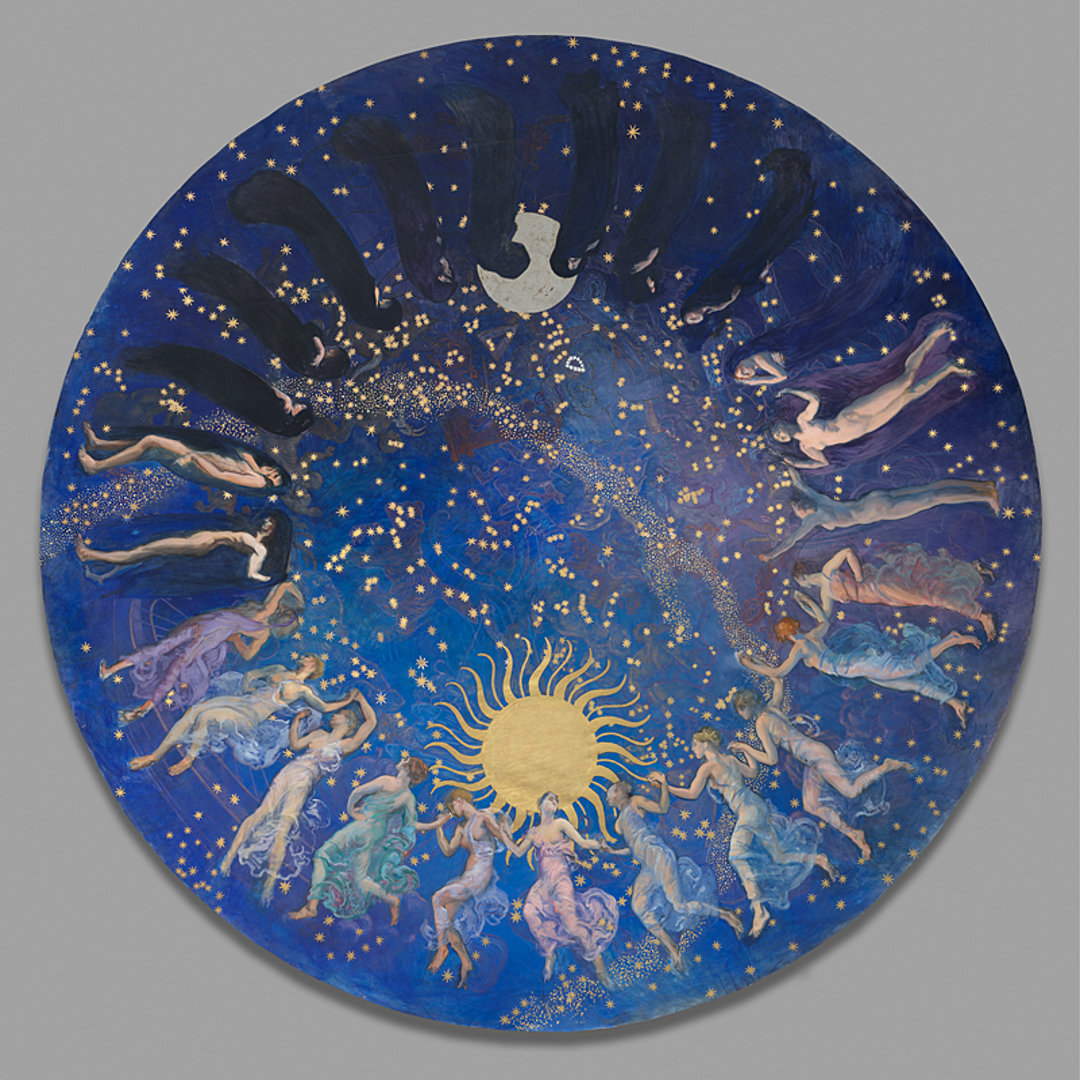Edwin Austin Abbey: By the Dawn’s Early Light
20 November 2025 – 15 February 2026
The H J Hyams Room (Room 1)
Admission free
A spectacular design for the ceiling of the House of Representatives, Pennsylvania State Capitol, Harrisburg – a palace of arts and one of the grandest public buildings ever constructed in the USA – will go on display at the National Gallery in winter 2025.
The 12-feet-diameter half-scale design for 'The Hours' depicts 24 female figures representing the 24 hours of the day. Newly conserved by Yale University Art Gallery, New Haven, Connecticut, this monumental work will be displayed as part of the first UK exhibition – for over a century – dedicated to its creator, the Philadelphia-born artist Edwin Austin Abbey (1852–1911). The exhibition subtitle, the second line of 'The Star-Spangled Banner', emphasises the importance of time and eternal vigilance in a legislator’s duties.
Edwin Austin Abbey: By the Dawn’s Early Light explores Abbey’s last major project, carried out between 1902 and 1911; the paintings and drawings on display were produced as studies for murals in the Pennsylvania State Capitol, Harrisburg. Edwin Austin Abbey worked on two designs for the House of Representatives, 'The Hours' for the ceiling and a vast wall mural entitled 'The Apotheosis of Pennsylvania' on the wall behind the Speaker’s dais.
Six preparatory studies for his 'Apotheosis', including representations of English statesman Sir Walter Raleigh (1552–1618) and American pioneer and frontiersman Daniel Boone (1734–1820), and other innovative designs of allegorical subjects for lunettes in the Rotunda of the Capitol, representing 'The Spirit of Vulcan' and 'The Spirit of Light', are included in the exhibition.
In 1908 Abbey, who lived and worked in the UK, borrowed an entire display hall at the University of London to show the first of his Harrisburg murals – guests included King Edward VII and Queen Alexandra – before shipping them to the USA for installation in the Capitol Rotunda. He would do the same in early 1911, borrowing the vast Machinery Hall built for the 1908 Franco-British Exhibition in London’s White City to assemble his remaining, and largest, scenes, including both 'The Hours' and 'The Apotheosis of Pennsylvania'.
'Edwin Austin Abbey: By the Dawn’s Early Light' will introduce British audiences to an artist who was well known when he lived in England between 1878 until 1911 and was a close friend to fellow expatriates like John Singer Sargent and Henry James – but who is now largely forgotten.
Working in an era of sweeping change after the devastation of the American Civil War*, Abbey was from an ambitious generation of American artists that focused on the human figure as the bearer of meaning in civic art. Part of the American Renaissance, a period in American public art and architecture that lasted from 1876 to 1917, Abbey painted at a time of new-found artistic ambition that was inspired by Italian Renaissance humanism.
The oil-on-canvas design for 'The Hours' and other preparatory studies that will go on display in the exhibition come from the rich holdings of Yale University Art Gallery, the largest repository of Abbey’s works. Over 3,000 works in different media – pen and ink, pencil, watercolour, pastel, chalk, charcoal and oil showing the proficiency of Abbey – were bequeathed by his widow in 1937 and have been the subject of a dedicated conservation project at the Yale University Art Gallery in advance of the present display.
'Edwin Austin Abbey: By the Dawn’s Early Light' follows a series of National Gallery exhibitions introducing major 19th and 20th-century American artists to UK and European audiences: George Bellows (1882–1925) and the Ashcan painters in 2011; Frederic Church (1826–1900) in 2013; Thomas Cole (1801–1848) in 2018; and Winslow Homer (1836–1910) in 2023; and exhibitions about contemporary American artists Ed Ruscha in 2018 and Kehinde Wiley in 2022.
'Edwin Austin Abbey: By the Dawn’s Early Light' is curated by Christopher Riopelle, Neil Westreich Curator of Post 1800 Paintings at the National Gallery with Mark D. Mitchell, Holcombe T. Green Curator of American Paintings and Sculpture at the Yale University Art Gallery.
Christopher Riopelle, Neil Westreich Curator of Post-1800 Paintings at the National Gallery, says ‘A sophisticated international-minded figure based in London, Abbey observed all the most exciting trends in European art circa 1900, not least Symbolism, and brilliantly translated them into an American ‘vernacular’ suitable for the vast public projects then rising on the other side of the Atlantic. It is thrilling to discover his distinctive, engaging and experimental vision.’
Mark D. Mitchell, Holcombe T. Green Curator of American Paintings and Sculpture at the Yale University Art Gallery, says ‘Edwin Austin Abbey’s contributions to the history of art are often most vividly apparent in his studies, which present his creative vision at its most dynamic and vital. In this exhibition, we look over his shoulder as he develops his ideas for the grand figurative conceptions with which he inspired his age.’
More information at nationalgallery.org.uk
Twitter @nationalgallery
Facebook @thenationalgallery
Instagram @nationalgallery
YouTube @nationalgallery
TikTok @nationalgallerylondon
Threads @nationalgallery
The H J Hyams Exhibition Programme
Supported by The Capricorn Foundation
Notes to editors
*The American Civil War was a conflict between the Union (the North) and the Confederacy (the South) that lasted from 1861 to 1865. It was the deadliest war in American history and resulted in the end of slavery in the US.
Image credits:
X12261
Edwin Austin Abbey
'Study for The Hours in the Pennsylvania State Capitol, Harrisburg, about 1909–11'
Oil on canvas, 381 cm diameter
Yale University Art Gallery, Edwin Austin Abbey Memorial Collection, 1937.1716
Image courtesy of Yale University Art Gallery
Short biography
Edwin Austin Abbey (1852–1911) was an American muralist, illustrator and painter. He flourished at the beginning of what is now referred to as the ‘golden age’ of illustration and is best known for his drawings and paintings of Shakespearean and Victorian subjects, as well as for his painting of Edward VII's coronation. His most famous set of murals, The Quest and Achievement of the Holy Grail, adorns the Boston Public Library.
Long biography
Edwin Austin Abbey (born in Philadelphia in 1852) started his career as an illustrator, producing numerous illustrations and sketches for magazines, including Harper's Weekly (1871–1874) and Scribner's Magazine. His illustrations began appearing in Harper's Weekly before Abbey was twenty years old. In 1878, he moved to England at the request of his employers to gather material for illustrations of the poems of Robert Herrick, published in 1882, and he settled permanently there in 1883. In 1883, he was elected to the Royal Institute of Painters in Watercolours and in 1896 he was elected Associate member of the Royal Academy, becoming a full member in1898. He received a gold medal at the Pan-American Exposition and was commissioned to paint the coronation of King Edward VII in 1901. It was the official painting of the occasion and, hence, resides at Buckingham Palace.
Abbey completed his most famous set of murals for the Boston Public Library in the 1890s. The frieze for the Library was titled ‘The Quest and Achievement of the Holy Grail’. It took Abbey eleven years to complete this series of murals in his England studios in London and Fairford. In 1897, he received the honorary degree of Master of Arts from Yale University. In 1902, Abbey began an ambitious program of murals for the new state capitol building under construction in Harrisburg, Pennsylvania. He commenced with allegorical medallions representing Science, Art, Law, and Religion for the dome of the Rotunda along with four large lunettes beneath its dome. He would also create vast historical murals for the front of the House of Representatives Chamber as well as an allegory for its ceiling, The Hours. Although he received further commissions for the Capitol’s Senate Chamber and Supreme Court, Abbey would die of cancer in London in 1911 before turning to them in earnest.
The National Gallery is one of the greatest art galleries in the world. Founded by Parliament in 1824, the Gallery houses the nation’s collection of paintings in the Western European tradition from the late 13th to the early 20th century. The collection includes works by Artemisia Gentileschi, Bellini, Cezanne, Degas, Leonardo, Monet, Raphael, Rembrandt, Renoir, Rubens, Titian, Turner, Van Dyck, Van Gogh and Velázquez. The Gallery’s key objectives are to care for and enhance the collection and provide the best possible access to visitors. Admission free.
Yale University of Art Gallery
Founded in 1832, the Yale University Art Gallery is the oldest college art museum in America. Today, it is a center for teaching, learning, and scholarship and a preeminent cultural asset for Yale University, the wider academic community, and the public. The museum collects, preserves, studies, and presents art in all media, from all regions of the globe and across time, with a collection numbering nearly 300,000 objects. The Gallery is open to all, free of charge, and is committed to engaging audiences through thoughtful, creative, and relevant exhibitions, programs, and publications.
Also on display at the National Gallery at the same time:
Radical Harmony: Helene Kröller-Müller’s Neo-Impressionists (13 September 2025 – 8 February 2026)
Wright of Derby: From the Shadows (7 November 2025 – 10 May 2026)
For more information
National Gallery Press Office on 020 7747 2865 or email National Gallery Press Office press.external@nationalgallery.org.uk
Publicity images can be obtained from https://press.nationalgallery.org.uk/

